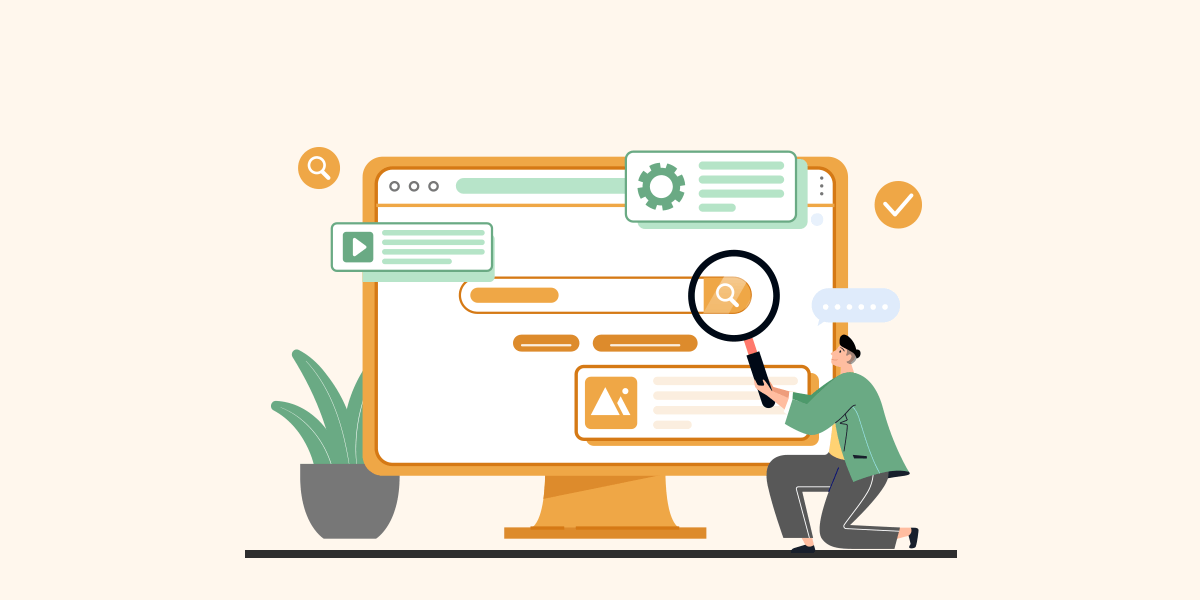,seo marketing,what is seo and how it works,seo tools,seo google,seo meaning in business,seo courseseo marketing,seo tools,seo google,seo course,seo meaning in business,seo strategy,types of seo,seo full form
It is great to find your site at the top of the search results on Google and thus win a large number of visitors. But it is not that simple, as it requires great care in order to improve the search engines (SEO) of your site. With some simple steps, you can bypass thousands of competitors for your site and rank at the top of the search results, and even maintain it if you master the required strategies. You should know that the quality of your site's content is not the only factor that plays an important role in your site's ranking in search results. Therefore, if you are looking for other ways and strategies to improve the SEO of your site, in this guide we will provide you with everything you need.
table of contents:
What is the importance of search engine optimization (SEO)?
The importance of the SEO assessment of your site lies in the fact that it is the main criterion upon which search engines, led by Google, rely in order to evaluate and compare the usefulness and quality of your site's content with other competing sites. As you know there are millions of websites and they must be sorted and categorized according to the value of each one.
What you have to do if you want to make your site public and make it top the search results is to know the criteria search engines, Google in particular, are looking for. You also need to determine what sites rank on the first page of search results, which is your goal and the goal of most of your competitors. Well, here are briefly the most important criteria that play an important role in the website's ranking in search results.
The most important criteria that affect the issuance of sites for search results
- Content quality: Is the content valuable to viewers? Does it meet the needs of visitors or is it just keywords scattered here and there? Good and valuable content is the basis for the SEO evaluation of any page on any site.
- Page loading speed: Will the page elements load process be smooth and fast, or will the user have to wait a long time to browse the content? Page loading speed is one of the most important elements of SEO according to Google.
- PageRank: It depends on the presence of valid internal and external links (text or backlinks). Internal links are between the pages of your site themselves, and they help the reader to navigate more and learn about topics related to what he wants. Backlinks are divided into two types: external links to other official pages or sources of general information, for example the NASA space page, and backlinks or text links that other pages place based on your site's pages as a source of information in them.
- Site traffic rate: This includes the CTR click rate and the number of clicks or the total number of visits.
- The rate of visits or traffic within a single page: This criterion is related to the quality of the content. The more the content is of real value and benefit to the visitor, the longer he stays on the page and the higher the traffic rate (traffic) for this page, and here the Google search engine understands that this page was of value to the user Because he kept browsing it for a longer time, and vice versa.
- Choosing the right keywords : This element is essential in order to gain visitors and target exactly the topics they are looking for.
- Continuous updating of content: keeping pace with recent developments, including updating links on pages and renewing sources in case they become outdated.
SEO Strategies
The search engine optimization process is not limited to keyword research, but the content of the website must be organized based on several strategies, which improve its visibility in search results and increase the rate of organic traffic and visits. Here are 6 of the most important SEO strategies:
1. Optimize your front page CTR
Here, by CTR, we mean the click-through rate, that is, the rate of visits that your page that previously topped the search results, and the most important factor to increase this rate is the attractive headline and page description (Meta Description). What you have to do is to draw the attention of browsers to the content of your page through the short description of the content of the page and the title of the main page (Title tag), which appear to the browsers in the search results.
You may be wondering why should I care about the title and description of my page if it is already at the top of the search results? Isn't issuing search results and my site appearing on the first page enough to bring visitors? Well, having your site topped the results will definitely bring you surfers, but not at the rate that you will get if you combine the title, the attractive description, and the top of the results.
When the search results appear for a specific keyword, what do you think is the first goal for most surfers? If you answered that it is the first site, then your answer is not accurate, the exact answer is that the destination for most people will be the most attractive address and the description closest to the topic they are looking for.
Suppose there are 10,000 users who search for “football” on Google, and 7,000 of them choose the second result because of its catchy title, what will the Google search engine understand now? They will understand that the second site is more relevant and valuable than the first, and the valuable site will be at the top of the results in no time, mainly because of the unique title, in addition to the content and other helpful elements of course.
Do you now have to edit the titles and descriptions of all your pages and make them more attractive? Of course not, the amount of work would be too great. What you need to do is select pages that have high traffic but low click-through rate (CTR), less than 5%. There are many services that help you find these pages, most notably the Google Search Console service . The steps for finding those pages and the best keywords to exploit are simple, as follows:
- Enter your website data into the Google search console
- Then click on Google search results
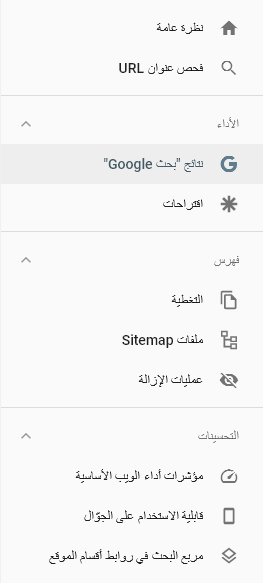
- You will see statistical data for your site's pages, including various details of site visits
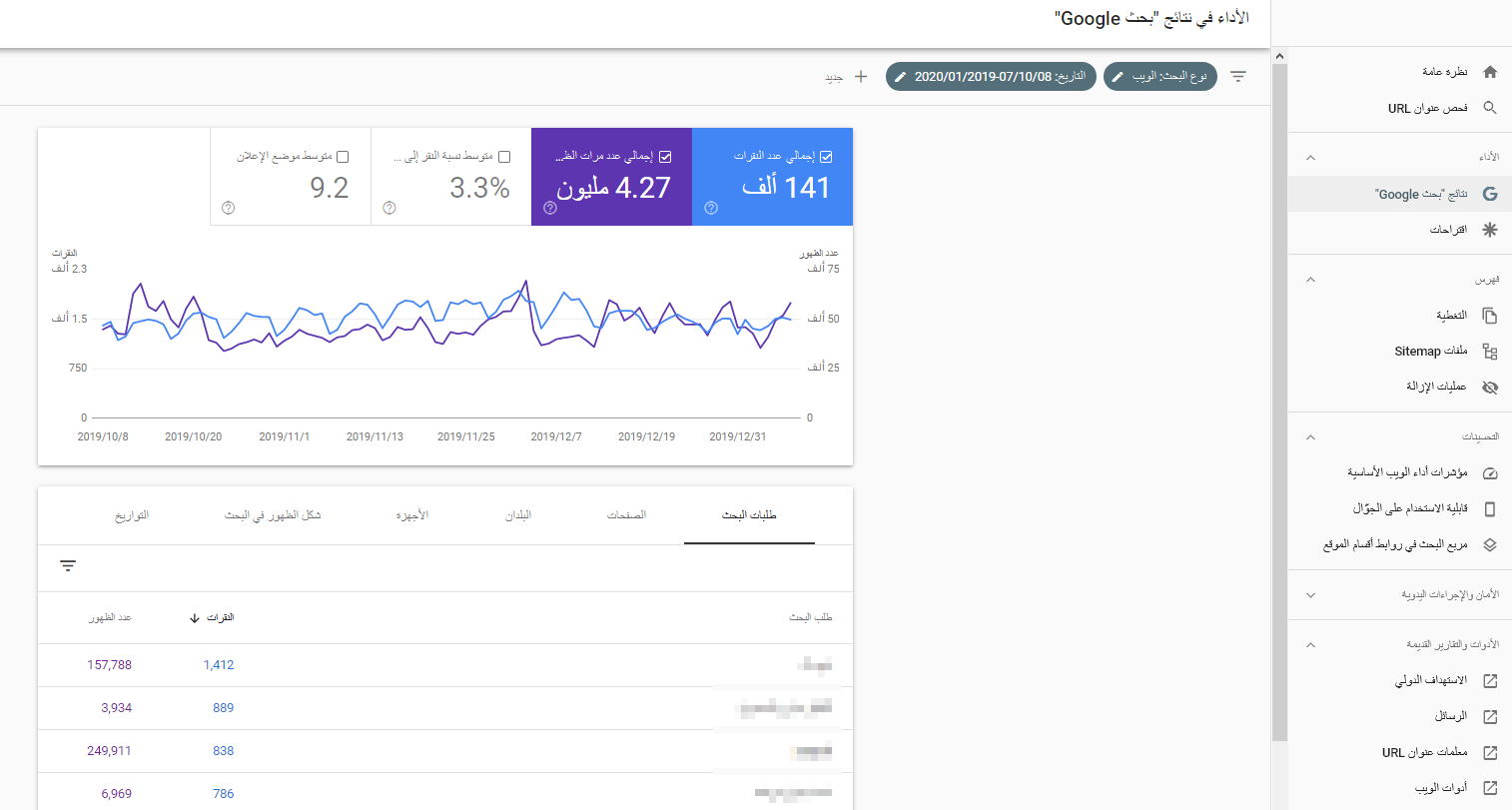
- Now choose the “Pages” tab, then check the “Avg. CTR” option to find your pages in descending order based on the number of clicks you get.
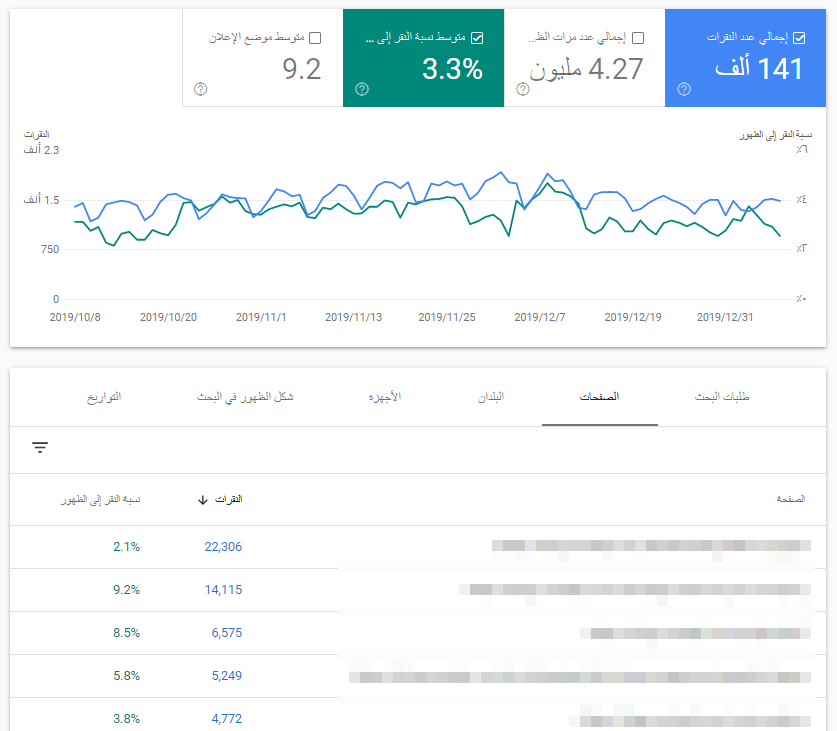
- Search for pages that have a lot of visitors but a low click-through rate, less than 5% and choose one, then click on the Queries option.
- You will now see the keywords that this page is ranking for along with the number of clicks and click rate for those keywords
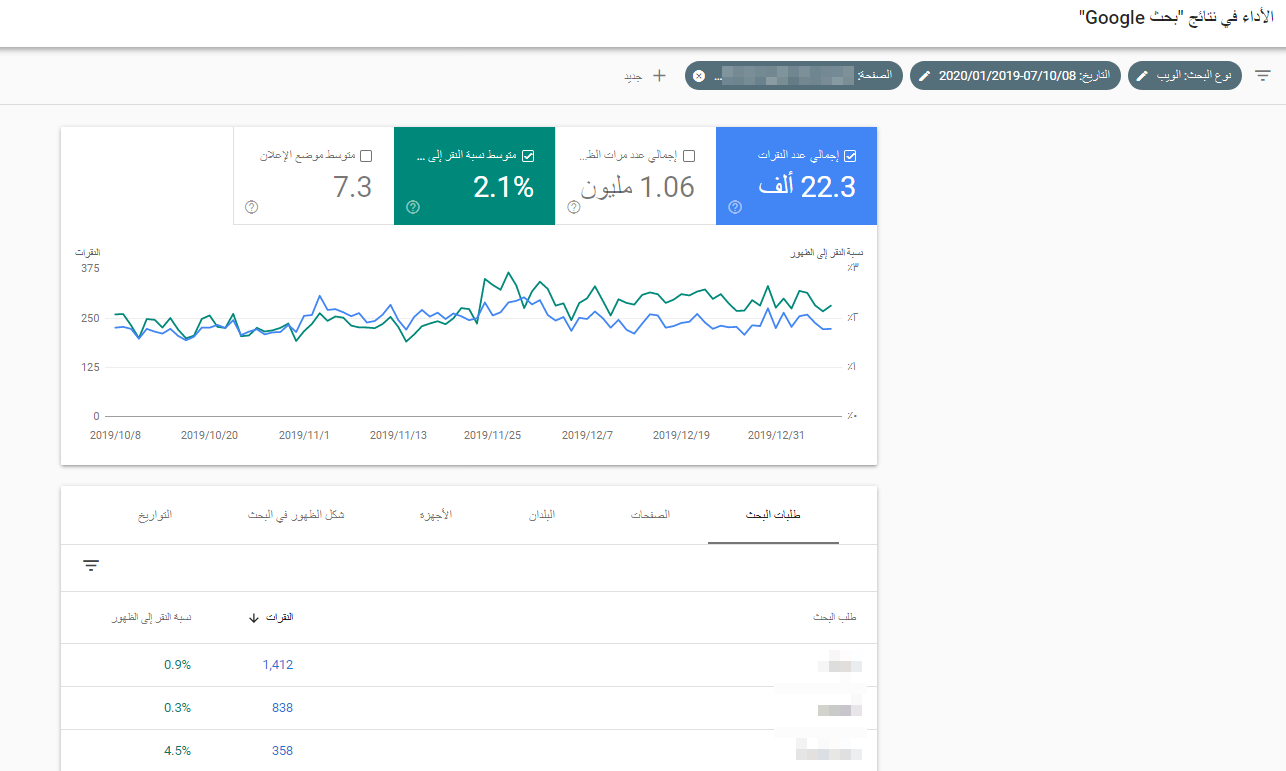
- Choose among the keywords the ones with the highest number of clicks and the lowest click rate
- These are the keywords that you should focus on when crafting the title and description of that page
After you have identified your pages and candidate keywords, you should make their title and description a catchy target that does not make the browser think twice before clicking on your page. Here are some helpful tips for that:
- Play on the chord of curiosity for visitors . Most visitors are looking for something that arouses their curiosity and need answers that satisfy their needs. Find the essence of the topic your page or article revolves around, and put it in an interesting and somewhat mysterious language.
It will definitely help you to use the interrogative, superlative and exclusive methods. For example, if the keyword is “search engine optimization,” the following headings would be a good option:
- Top 7 Strategies for SEO Search Engine Optimization
- 10 Strategies that will make your site top the search results
- Learn the simplest strategies for getting to the top of the search results
- Avoid long titles: How many times have you decided not to enter a page because its title in the search results is incomplete and does not appear in its entirety? The title of your page must appear in its entirety, and here you must choose a title of no more than 60 characters in order for the Google search engine to show it completely.
- Choose strong words and adjectives and put them in your title: Here, by strong words and adjectives, we mean those whose psychological impact on the reader is effective. Examples of them are: tips (essential, basic, or golden) in order for your site to (top, excel, dominate, or dominate) your site in the search results.
- Choose the appropriate keyword: As we explained above, you should focus in the title and description on the most prominent and best keyword in terms of the number of searches that your article or page addresses. As you know, the article may include tens or even hundreds of keywords according to which the page is classified. Therefore, select the most prominent keywords and attach them to the page title, describing them in a unique style.
2. Improved page loading speed
Most users get frustrated when they come across pages that take a long time to load, and then leave to go to another source. This regression phenomenon is gradually depleting your page's SEO! The pages that Google sees that users are browsing but quickly exit from them to others, their ranking drops significantly, and vice versa. The longer your page grabs and keeps users' attention, the higher it will rank in search results.
Here lies the importance of adjusting the loading speed of your site's pages and making them as smooth as possible without affecting the quality of displaying content or affecting the experience of users or readers. We mentioned earlier that the speed of loading pages is one of the factors and points approved by Google that play a prominent role in the appearance of the page at the top of the search results.
Fortunately, Google has provided us with a free PageSpeed Insights tool for measuring page loading speed . This tool will give you a comprehensive view of your download problems and suggest appropriate solutions to address them, and it is completely free, so it should be one of the main stations at which you will stand in the SEO journey of your site.
PageSpeed Insights tool has a simple and easy-to-use interface, but the main difficulty is that you have to measure the loading speed of each page of your site separately. This will be very hard work if your site has hundreds of pages.
Therefore, we suggest that you identify the pages that have a good ranking in the search results and the rate of visitors is large and give them priority in adjusting their browsing speed, so that these pages are the key to fame and the main drive for visitors to your site. You can investigate the pages that lead the search results on your site through the Google Analytics service .
After selecting your selected pages, go to the PageSpeed Insights tool website, add the link to each page separately, and click on the Analyze icon. Google will give you a score indicating the page speed rating and below it the obstacles that affect the loading speed and suggestions to solve them. You may find a variety of loading problems on your pages, but the most prominent problems that most sites face are:
Pages size
What is meant here is the size of the html file that includes all the contents of a specific page, in other words, the amount of contents that the page can accommodate. Therefore, if your pages are large and full of interactive elements such as images and videos, your visitors will face a real problem in the loading process. Here are some tips to avoid this problem:
- Reduce the size of the images as much as possible while maintaining sufficient accuracy: Generally, if the images are illustrative and basic to explaining the information on your page, they must be completely clear. If they are illustrative, then you should not exaggerate the size and accuracy of the image, because it will clearly affect the loading speed.
- The choice of image format is also important: the most popular ones are jpeg, png, and GIF. The jpeg format is suitable for images with many colors and is distinguished by its high compression ability, while the png format is suitable for images with less color, as the images that include many colors in the png format will be larger than the jpeg images of the same resolution. As for the GIF format, it consumes more size than its predecessor, so try to avoid it unless necessary.
- Remove unnecessary font styles: Of course, it would be nice to decorate your page content with attractive types of fonts, but they put an extra burden on the loading speed, so choose only the best places for them.
- Use a cloud compression program: Take advantage of the Gzip program to compress and decompress files during the data transfer process between the server of your site and the user visiting your pages, the program is completely free.
2. Website Bandwidth
The website domain represents the amount of data that can be exchanged between your website server and the user's browser over a certain period of time. The larger your site's domain, the faster your pages will load, especially if you have a lot of visitors. If the demand for downloading your website pages is large, then you need a large domain for your site.
If you have purchased a domain package from your web server, you should evaluate if it is enough for your current downloads? Will you meet the increasing pressure on your pages? If your page is facing problems with loading speed, you should expand the site's domain package, or you can resort to another trick, which is the use of CDN services.
CDN services are an abbreviation for the “Content Delivery Network” service, which are intermediary platforms that connect your site to its own servers so that copies of your site’s pages are stored there, and when there is excessive pressure on your site, this pressure is transferred to the intermediary servers.
In other words, if your site can handle 10,000 downloads at one time, but the current pressure is 13,000, then instead of the additional 3,000 users suffering from a slowdown in the loading speed of your page, their download requests are transferred to the intermediate server, which has an exact copy of the requested page, and displays it immediately to the user without No drop in download speed. Prominent content delivery services include: Cloudflare, Amazon CloudFront, MaxCDN, and W3 Total Cache.
Another simple technique you can add to speed up your site is browser caching, so users don't have to load the page a second time when they visit it and then exit and return to it. The most prominent plugin that provides you with this feature is W3 Total Cache , as this service helps you improve the quality and speed of loading your site pages through caching and using the CDN strategy that we mentioned earlier.
3. Exploiting internal links
Internal links are links that link the different pages of your site to each other, and when you use them correctly and not randomly, your pages will jump through the search results in a way that may surprise you. You may be wondering why internal links are so important in SEO?
Well, internal links help and support PageRank - which we mentioned at the beginning of the article - across your site. In other words, when Google sees that your page has a homogeneous distribution of internal links for keywords related to the topic of the page, it puts it under the category of useful pages and raises its ranking in the search results. You can think of internal links as practical proof of how much content your page presents to the user.
Exploit the distribution of internal links on pages that need a little push to reach the top of the search results. This will be a good strategy in the short term, and you will definitely notice it. Determine which pages rank well in the search results, which are the pages that rank between #7 and #14 in the results, via Google Analytics. These pages are a golden opportunity to hunt the first results page, as they have already succeeded in reaching the second or third pages and are a good candidate for topping the results. Finding the right internal links is very simple, here are the steps to do it:
- Select the main keyword on the target page, let's say it is "e-marketing".
- Type the following formula: site:your site name.com “the main keyword” In our example, the formula would be: site:khamsat.com “e-marketing”

- You will see all the pages related to the keyword you selected. Then you can link the appropriate ones on the main page with relevant keywords (anchor text).
In our example, we can link the phrase “e-marketing applications”, which will be mentioned on the home page, with the article “ The 8 best applications you need in e-marketing .”
4. Fill in the gaps in your pages
Browsers have different methods to search for topics that arouse their curiosity. The same keyword is formulated in dozens of ways, all of which have one meaning. Search engines are aware of this, so they often take into account multiple keywords for the same topic while evaluating the content and ranking of pages in search results.
For example, if you search for “online shopping,” you will find a specific list of pages at the top of the results. Now, if you try searching for “online shopping”, you will find similar results, meaning that some pages top the search results for the topic of online shopping in general. This phenomenon is not accidental, of course. Pages that top the results for many keywords with a common theme are well structured and include the main keyword as well as the sub-words in one good context.
Now your task is to exploit this phenomenon in the search engine optimization of your site by tracking the keywords that your pages are lacking and that can top the search results, since the keyword is at the top of the results. For example, your article on “e-marketing” may top searches for “e-marketing” but miss out on a search for “online marketing”, even though your page touches on both meanings, simply because you didn’t include “ Online Marketing” in the keywords of that page.
If you can include different candidate keywords in searches for a specific topic, you will not only dominate the results in searches for the main keyword, but you will also increase your page rank in searches for secondary keywords. This means that you will bring more traffic and more CTR to your page, which in turn will increase the value of your site's content to Google's treasury.
You can find the best secondary keywords that will fill in the gaps on your page by researching and studying competing pages, how? Well, there are many SEO tools that allow you to identify the secondary keywords that lead the pages that dominate the search results for a particular keyword.
Among the most prominent of these tools is Content Gap and Organic Research Competitors report, which are two paid services that are not free, but they will provide you with accurate results that will help you discover important secondary keywords for a specific topic that you may have overlooked.
5. Fix the backlinks to your site
Backlinks or backlinks are hyperlinks that are placed on a specific word or phrase and lead the user to a specific site. Within your site, there will be hundreds of internal links that combine the information of your different pages. There will also be external links within other sites that infer information on your pages. These links are valuable and must be completely valid, and ensuring their validity is a priority if you want to benefit from them in the search engine optimization of your site.
There are many tools that help you identify damaged text links to your site, including: screaming Frog SEO Spider and Ahrefs. In our example, we will mention the Ahrefs Site Explorer program , and the steps are simple and are as follows:
- Subscribe to the program and register your own account on it
- Enter your website extension, khamsat.com for example
- From the left menu under the “Pages” icon, select the “Best by links” option.
- Add the “404 not found” option, then arrange the results according to the number of sites that pointed to a specific page via an invalid link (as in the picture)
- You will get a list of your invalid pages that other sites have indicated as their source of information. Here, when browsers click on your page links, they will see an error and will not be able to load the page.
The link is invalid for two reasons:
- The first: is that there is an error in the other site listing the link to your page, for example, there may be a number, letter, or even a plus or minus symbol from the link, and here you must review the owner of the site and alert him of the error in the link of your page.
- The second: is that the error is in the link of your page or its content, as you may have previously deleted the content of the page or renewed its link, and here he must redirect the link on the site hosting your page link to another related page in order not to lose visitors from other sites who want to see information on your page.
6. Use of SEO search engine optimization services
You may run into some complications while going through the above strategies. In this case, there is no harm in seeking the help of experienced people, as there are SEO specialists who can achieve qualitative changes for your site.
You can choose the appropriate service by searching for service evaluations and the quality of the work provided, or through the opinions of previous clients who used SEO services previously and had a positive experience and obtained the desired results. You can also hire an SEO expert through a freelance platform if you need to adjust a lot of things and check the SEO standards for your site pages.
This was our pick list of the best simple strategies that can significantly improve your website's SEO. If your site has not yet gained enough popularity and has not imitated the first search results on Google, then you should start moving quickly. Do not hesitate. It is not that complicated, all you have to do is devote some time, effort and resources to developing your site’s SEO.
,seo marketing,what is seo and how it works,seo tools,seo google,seo meaning in business,seo courseseo marketing,seo tools,seo google,seo course,seo meaning in business,seo strategy,types of seo,seo full form

